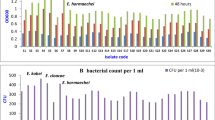Abstract
The aims of this study were to isolate metal bioaccumulating bacterial strains and to study their applications in removal of environmental problematic heavy metals like mercury. Five bacterial strains belonging to genera Enterobacter, Bacillus, and Pseudomonas were isolated from oil-spilled soil. Among these, one of the strains Enterobacter sp. EMB21 showed mercury bioaccumulation inside the cells simultaneous to its bioremediation. The bioaccumulation of remediated mercury was confirmed by transmission electron microscopy and energy dispersive X-ray. The mercury-resistant loci in the Enterobacter sp. EMB21 cells were plasmid-mediated as confirmed by transformation of mercury-sensitive Escherichia coli DH5α by Enterobacter sp. EMB21 plasmid. Effect of different culture parameters viz-a-viz inoculum size, pH, carbon, and nitrogen source revealed that alkaline pH and presence of dextrose and yeast extract favored better remediation. The results indicated the usefulness of Enterobacter sp. EMB21 for the effective remediation of mercury in bioaccumulated form. The Enterobacter sp. EMB21 seems promising for heavy metal remediation wherein the remediated metal can be trapped inside the cells. The process can further be developed for the synthesis of valuable high-end functional alloy, nanoparticles, or metal conjugates from the metal being remediated.






Similar content being viewed by others
References
Klaus-Joerger, T., Joerger, R., Olsson, E., & Granqvist, C.-G. (2001). Trends in Biotechnology, 19, 15–20.
Gadd, G. M. (2004). Geoderma, 122, 109–119.
Haferburg, G., & Kothe, E. (2007). Journal of Basic Microbiology, 47, 453–467.
Lloyd, J. R., Byrne, J. M., & Coker, V. S. (2011). Current Opinion in Biotechnology, 22, 509–515.
Narayanan, K. B., & Sakthivel, N. (2010). Advances in Colloid and Interface Science, 156, 1–13.
Hylander, L. D., & Goodsite, M. E. (2006). Science of the Total Environment, 368, 352–370.
Wang, Q., Daekeun, K., Dionysiou, D. D., Sorial, G. A., & Timberlake, D. (2004). Environmental Pollution, 131, 323–336.
Bafana, A., Krishnamurthi, K., Patil, M., & Chakrabarti, T. (2010). Journal of Hazardous Materials, 177, 481–486.
Pepi, M., Gaggi, C., Bernardini, E., Focardi, S., Lobianco, A., Ruta, M., Nicolardi, V., Volterrani, M., & Gasperini, S. (2011). International Biodeterioration & Biodegradation, 65, 85–91.
Lee, S. E., Chung, J. W., Won, H. S., Lee, D. S., & Lee, Y.-W. (2012). Bulletin of Environmental Contamination and Toxicology, 88, 239–244.
Green-Ruiz, C. (2006). Bioresource Technology, 97, 1907–1911.
Das, S. K., Das, A. R., & Guha, A. K. (2007). Environmental Science & Technology, 41, 8281–8287.
Sari, A., & Tuzen, M. (2009). Journal of Hazardous Materials, 171, 500–507.
Chen, J. Z., Tao, X. C., Xu, J., Zhang, T., & Liu, Z. L. (2005). Process Biochemistry, 40, 3675–3679.
Bayramoğlu, G., Tuzun, I., Celik, G., Yilmaz, M., & Arica, M. Y. (2006). International Journal of Mineral Processing, 81, 35–43.
Barkay, T., & Wagner-Döbler, I. (2005). Advances in Applied Microbiology, 57, 1–53.
Zhang, W., Chen, L., & Liu, D. (2012). Applied Microbiology and Biotechnology, 93, 1305–1314.
Ruiz, O. N., Alvarez, D., Gonzalez-Ruiz, G., & Torres, C. (2011). BMC Biotechnology, 11, 2–8.
Deng, X., & Jia, P. (2011). Bioresource Technology, 102, 3083–3088.
Kiyono, M., & Pan-Hou, H. (2006). Journal of Health Science, 52, 199–204.
Altschul, S. F., Madden, T. L., Schaeffer, A. A., Zhang, J., Zhang, Z., Miller, W., & Lipman, D. J. (1997). Nucleic Acids Research, 25, 3389–3402.
Zhang, Z., Schwartz, S., Wagner, L., & Miller, W. (2000). Journal of Computational Biology, 7, 203–214.
Chun, J., Lee, J.-H., Jung, Y., Kim, M., Kim, S., Kim, B. K., & Lim, Y. W. (2007). International Journal of Systematic and Evolutionary Microbiology, 57, 2259–2261.
Izaki, K., Tashiro, Y., & Funaba, T. (1974). Journal of Biochemistry, 75, 591–599.
Sambrook, J., Fritsch, E. F., & Maniatis, T. (1989). Molecular cloning: a laboratory manual (2nd ed.). New York: Cold Spring Harbor Laboratory.
David, G. F. X., Herbert, J., & Wright, G. D. S. (1973). Journal of Anatomy, 115, 79–97.
Canstein, H. V., Li, Y., Timmis, K. N., Deckwer, W.-D., & Wagner-Döbler, I. (1999). Applied and Environmental Microbiology, 65, 5279–5284.
Barkay, T., Miller, S. M., & Summers, A. O. (2003). FEMS Microbiology Reviews, 27, 355–384.
Yamaguchi, A., Tamang, D. G., & Saier, M. H., Jr. (2007). Water, Air, and Soil Pollution, 182, 219–234.
Bogdanova, E. S., Mindlin, S. Z., Kalyaeva, E. S., & Nikiforov, V. G. (1988). FEBS Letters, 234, 280–282.
Robinson, J. B., & Tuovinen, O. H. (1984). Microbiological Reviews, 48, 95–124.
de Sotero-Martins, A., Jesus, M. S., Lacerda, M., Moreira, J. C., Filgueiras, A. L. L., & Barrocas, P. R. G. (2008). Brazilian J Microbiol., 39, 307–310.
Essa, A. M. M., Julian, D. J., Kidd, S. P., Brown, N. L., & Hobman, J. L. (2003). Antimicrobial Agents and Chemotherapy, 47, 1115–1119.
Belzile, N., Wu, G. J., Chen, Y. W., & Appanna, V. D. (2006). Science of the Total Environment, 367, 704–714.
Głuszcz, P., Petera, J., & Ledakowicz, S. (2011). Bioprocess and Biosystems Engineering, 34, 275–285.
Hamdy, M. K., & Noyes, O. R. (1975). Applied Microbiology, 30, 424–432.
Pan-Hou, H. S., Nishimoto, M., & Imura, N. (1981). Archives of Microbiology, 130, 93–95.
Bafana, A. (2011). Biometals, 24, 301–309.
Chien, M. F., Narita, M., Lin, K. H., Matsui, K., Huang, C. C., & Endo, G. (2011). Journal of Bioscience and Bioengineering, 110, 94–98.
Sinha, A., & Khare, S. K. (2011). Bioresource Technology, 102, 4281–4284.
Nascimento, A. M. A., & Chartone-Souza, E. (2003). Genetics and Molecular Research, 2, 92–101.
Acknowledgments
Authors gratefully acknowledge the funds provided by the Department of Biotechnology (Govt. of India) for supporting the work. A. Sinha is grateful to The University Grants commission (Govt. of India) for the senior research fellowship. S. Kumar is thankful to the Council of Scientific and Industrial Research (Govt. of India) for the award of senior research fellowship.
Author information
Authors and Affiliations
Corresponding author
Rights and permissions
About this article
Cite this article
Sinha, A., Kumar, S. & Khare, S.K. Biochemical Basis of Mercury Remediation and Bioaccumulation by Enterobacter sp. EMB21. Appl Biochem Biotechnol 169, 256–267 (2013). https://doi.org/10.1007/s12010-012-9970-7
Received:
Accepted:
Published:
Issue Date:
DOI: https://doi.org/10.1007/s12010-012-9970-7




